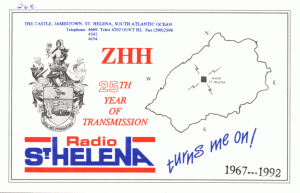This article first appeared in the March 1995 DX Times.
A small but keen bunch of Auckland DXers have over the years looked for St Helenas annual test transmission with varied degrees of success. Never has it been heard at anything better than poor. We have in the past operated from the Motu Moana Scout Camp in B0ckhouse Bay the site of the 1980 League Convention. Half wave dipoles and random long wires were used.
1994 was to be the year we tackled St Helena with scientific preparation. Everything was to be carefully planned, John West, Barry Williams and Ivor Williams ( ZL1AGO) initially studied the propagation for St. Helena
We decided on the short path, across the South Pole — but it would he marginal.
Next we considered the location. The abseiling tower at Motu Moana had recently had another 20 feet added to it, raising the tower to 50 feet high. Ivor had access to the key to the tower so it looked the logical place to hang our antennas from. Now, what type of antennas ? Ivor had a wire V beam antenna some 200 feet length per leg. I opted for this beaming north and south. It worked out approximately 3 wavelenghts per leg, giving a 5 db gain and a beam width of 60 degrees. Ivor and John had been discussing loop antennas for some weeks and designed a 3 element loop antenna cut for 11092 khz. This was duly assembled prior to the test date.
Saturday the 15th October saw the three of us assemble at the tower early in the morning to finish the erection of the antennas started by Ivor and John on the Friday afternoon. Bryan Clark joined us shortly before the test commenced and 2 ICOM R71Es and a Drake SPR4 were set up, tuned to the frequency ready to hear a clear opening announcement.
Unfortunately: not so. Yes there were signs of the station mixed with severe digital QRM similar to that which plagued us the previous year. After all that planning and effort , the only solace was that no other DXers in NZ heard St.Helena much better.
A few observations were made by those assembled. What was heard, was heard better on the V beam. The loop was quieter. Whether this was due to a narrower beam width, less gain or its direction , we don‘t kow. The question was raised; in fact which path, long or short, was the signal coming from? Later when talking to Tony Mar ( ZL2AGY ), I was told Dene Lynneberg had listened on a 20 metre beam and the best signal was coming from the north. An interesting observation but its value debatable as one is not too sure of the radiation pattern of a 20 metre beam receiving a 11 Mhz signal.
Although somewhat frustrated after the effort put in , there is now talk of constructing a trapped 3 element beam for 11 MHz and having it rotating manually on the top of the tower. If nothing else we might discover the actual path St. Helena is taking or where the QRM is coming from. . Roll on the next test transmission!




